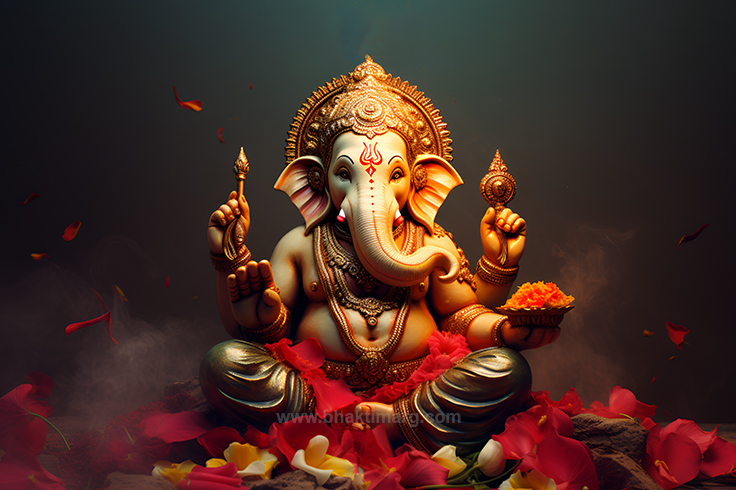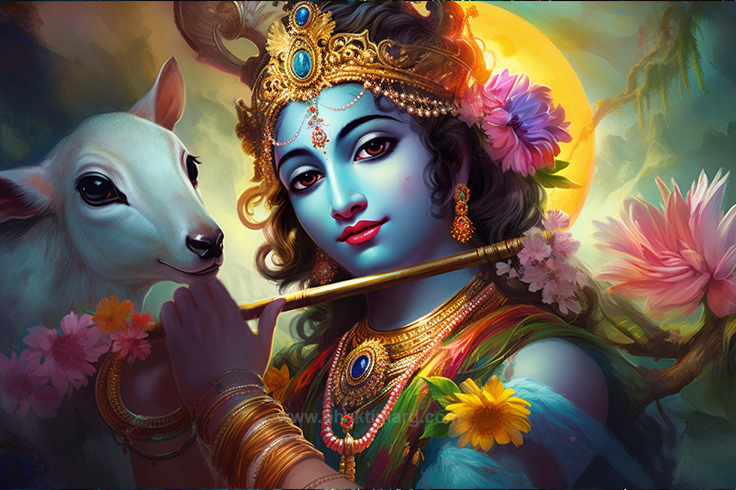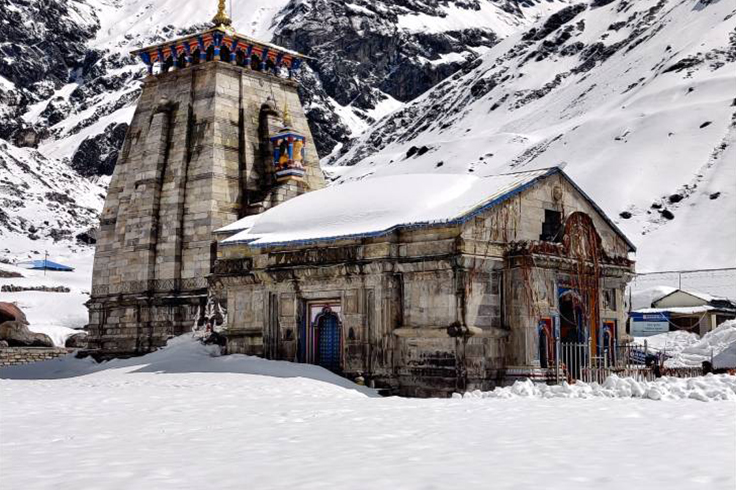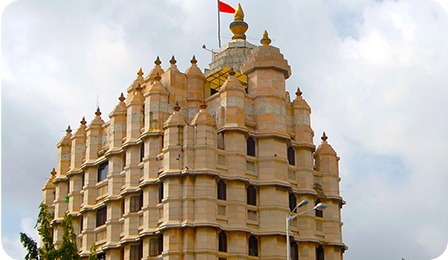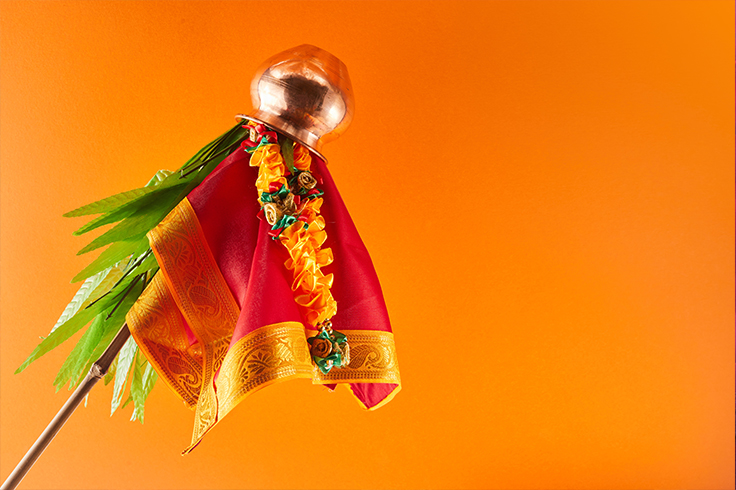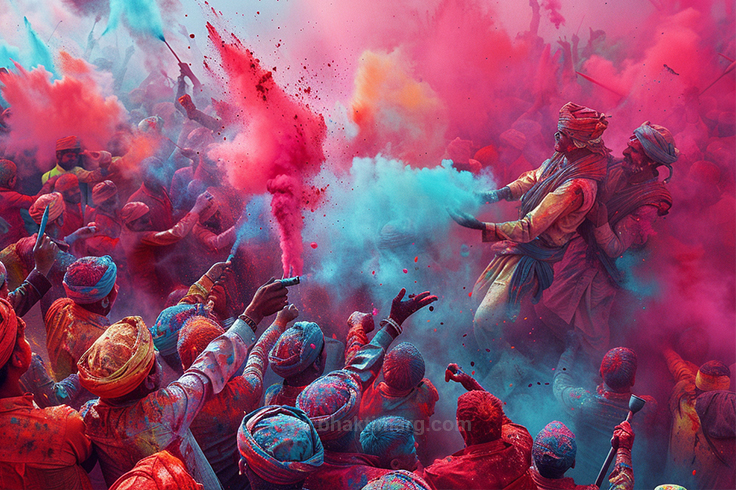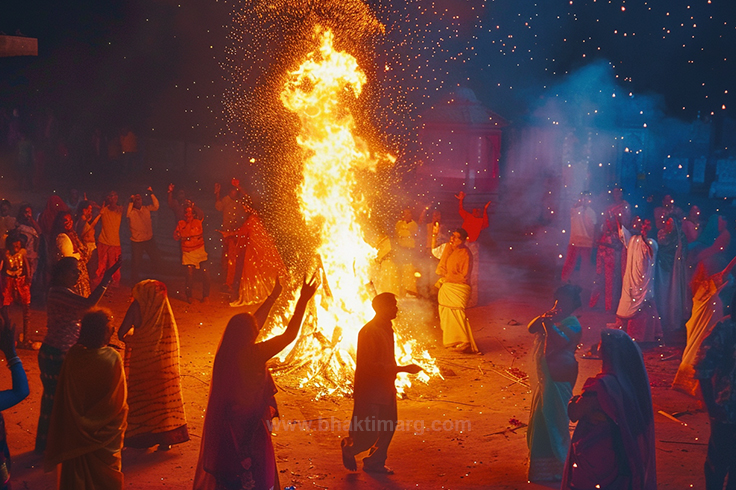Shree Hanuman Chalisa in English
|| Doha ||
Shri Guru Charan Saroj Raj, Nija Manu Mukura Sudhari |
Baranau Raghuvar Bimal Jasu, Jo Dayaku Phala Chari ||
Budheeheen Tanu Jannike, Sumiro Pavan Kumara |
Bal Buddhi Vidya Dehoo Mohee, Harahu Kalesh Vikaar ||
|| Chaupai ||
Jai Hanuman Gyan Gun Sagar | Jai Kapis Tihun Lok Ujagar ||
Ram Doot Atulit Bal Dhama | Anjani Putra Pavan Sut Nama ||
Mahabir Vikram Bajrangi | Kumati Nivar Sumati Ke Sangi ||
Kanchan Varan Viraj Subesa | Kanan Kundal Kunchit Kesha || 4
Hath Vajra Aur Dhwaja Viraje | Kaandhe Moonj Janeu Saaje ||
Sankar Suvan Kesri Nandan | Tej Prataap Maha Jag Vandan ||
Vidyavaan Guni Ati Chatur | Ram Kaj Karibe Ko Aatur ||
Prabhu Charitra Sunibe Ko Rasiya | Ram Lakhan Sita Man Basiya || 8
Sukshma Roop Dhari Siyahi Dikhava | Vikat Roop Dhari Lank Jalava ||
Bhim Roop Dhari Asur Sanhare | Ramachandra Ke Kaj Sanvare ||
Laye Sanjivan Lakhan Jiyaye | Shri Raghuvir Harashi Ur. Laye ||
Raghupati Kinhi Bahut Badai | Tum Mama Priya Bharat-Hi-Sam Bhai || 12
Sahas Badan Tumharo Yash Gaave | As Kahi Shripati Kanth Lagaave ||
Sankadhik Brahmaadi Muneesa | Narad Sarad Sahit Aheesa ||
Yam Kuber Dikpaal Jahan Te | Kavi Kovid Kahi Sake Kahan Te ||
Tum Upkar Sugreevahin Keenha | Ram Milaye Rajpad Deenha || 16
Tumhro Mantra Vibheeshan Maana | Lankeshwar Bhaye Sab Jag Jana ||
Yug Sahasra Yojan Par Bhanu | Leelyo Tahi Madhur Phal Janu ||
Prabhu Mudrika Meli Mukh Mahee | Jaladhi Langhi Gaye Achraj Nahee ||
Durgam Kaj Jagat Ke Jete | Sugam Anugraha Tumhre Tete || 20
Ram Duwaare Tum Rakhvare | Hot Na Agya Binu Paisare ||
Sab Sukh Lahai Tumhari Sarna | Tum Rakshak Kahu Ko Darna ||
Aapan Tej Samharo Aapai | Teenon Lok Hank Te Kanpai ||
Bhoot Pisaach Nikat Nahin Aavai | Mahavir Jab Naam Sunavai || 24
Nase Rog Harae Sab Peera | Japat Nirantar Hanumat Beera ||
Sankat Se Hanuman Chhudavai | Man Kram Vachan Dhyan Jo Lavai ||
Sab Par Ram Tapasvee Raja | Tin Ke Kaj Sakal Tum Saja ||
Aur Manorath Jo Koi Lavai | Soi Amit Jeevan Phal Pavai || 28
Charon Jug Partap Tumhara | Hai Parsiddh Jagat Ujiyara ||
Sadhu Sant Ke Tum Rakhware | Asur Nikandan Ram Dulare ||
Ashta Siddhi Nav Nidhi Ke Data | As Var Deen Janki Mata ||
Ram Rasayan Tumhare Pasa | Sada Raho Raghupati Ke Dasa || 32
Tumhare Bhajan Ram Ko Pavai | Janam Janam Ke Dukh Bisraavai ||
Antkaal Raghuvar Pur Jayee | Jahan Janam Hari Bhakt Kahayee ||
Aur Devta Chitt Na Dharahin | Hanumat Sei Sarv Sukh Karahin ||
Sankat Kate Mite Sab Peera | Jo Sumirai Hanumat Balbeera || 36
Jai Jai Jai Hanuman Gosain | Kripa Karahun Gurudev Ki Nayin ||
Jo Shat Bar Path Kare Koi | Chhutahin Bandi Maha Sukh Hoi ||
Jo Yeh Padhe Hanuman Chalisa | Hoye Siddhi Saakhi Gaureesa ||
Tulsidas Sada Hari Chera | Keejai Nath Hriday Mahn Dera || 40
|| Doha ||
Pavan Tanay Sankat Harana, Mangala Murati Roop |
Ram Lakhan Sita Sahita, Hriday Basahu Soor Bhoop ||
Shri Hanuman Chalisa is a devotional hymn religiously followed by devotees as the praise of Lord Hanuman, a prominent figure in Hindu devotional scriptures. The Lyrics of Hanuman Chalisa were written by the renowned Bhakti Poet Tulasidas in the 16th century, part of the Epic Poem ‘Ramcharitramanas’ in the Awadhi language. Hanuman Chalisa consists of 40 verses in the praise of dedicated God and hence the name Chalisa. Bhakti Marg brings you an excerpt on the topic guiding you on how and why bhakti will be guiding your life and soul toward the ultimate goal of Moksha.
Comprehensive Snippet on Hanuman Chalisa Stotra
Let’s get into the story of Lord Hanuman, also named ‘Pavan Putra’ for being born out of a blessing from the wind god ‘Pavan’ or ‘Vayu’. He is considered to be an incarnation of Lord Shiva and is highly revered by Hindus as one of the Cheeranjivis. It is believed lord Shiva wished to stay close to Lord Vishnu in his human Avatar and display his affection he took this form. Hence Hanuman is equally powerful, mighty, and giving, and for devotees to praise him there are various Hanuman Mandirs each having their own recognition granting the believer’s wishes. In Shree Hanuman Chalisa his unwavering devotion to Shri Ram the seventh avatar of Lord Vishnu is described in detail, along with other extraordinary attributes of his being, and Bhakti Marg has tried to maintain the same in portraying.
The Lord mentioned in the prayer is attributed as the epitome of strength, wisdom, courage, and celibacy, and its believed that Hanuman Chalisa Path would grant one the same distinction by the blessing of Lord Hanuman. Devotees have faith that the Jai Hanuman Chalisa recitation would pull them out of any form of fear, danger, or unpleasant situation. Hence the name Sankat Mochan Hanuman Chalisa, where Sankat Mochan means crisis response, so it is strongly believed by devotees that lord hanuman would save them from any crisis.
Religiously recounting sampoorna Hanuman Chalisa, following rituals and traditions related to the same is marked to have a positive effect on one’s life. The Hanuman Chalisa Stora is a praise written for the lord, describing his life details on how he acquired his titles and became known for his knowledge and strength. It portrays Hanuman Katha on how he is the biggest devotee of Lord Ram and has assisted many in life, along with playing a crucial role in saving Lord Ram’s wife Sita, and defeating Demon King Ravan. Hanuman Chalisa is a Bhakti Sangeet depicting all the achievements and qualities of Lord Hanuman by Tulasidas stating his belief that the praised lord would stand by his devotees. And the one who chants Hanuman Mantra would experience his protection and grace.
Benefits of Bajranbali Chalisa
Many times devotional and religious beliefs are scrutinized with logic there is a long-prevailing debate between hardcore devotees of Bhakti Marg and rationalists on whether one should let all on God and surrender to faith, or should work for their destiny.
Maruti Chalisa’s recital or any other devotional chant is not about not acting on duty but rather believing that we process our duty and that the Lord will assist us in difficult situations. As Shree Hanuman Chalisa’s lyrics say ‘Sankat Te Hanuman Chudave, Man, Karma Bachan Dhyan Jo Laave’, meaning that praying to the lord in your mind, actions, and words the lord will help you with problems.
There are astrological beliefs that reciting Shri Hanuman Chalisa would rid one of ‘Sate Sati’ the term for the heavy effect of Saturn planet on one’s life pertaining to negative energy and result in one’s bad Karma, as it is said that Bhakti Marg cancels your bad deeds and promote good deed recital of Hanuman Chalisa is one of the solutions.
Hanuman Chalisa Lyrics are the story of the praisable lord, when recited to growing kids can imprint the same spirit to fight for destiny, achieve success and develop a positive upbringing shaping a person charter strong, courageous, and humble at the same time.
As sound is said to have a great effect and revibrates in the universe recounting Shir Guru Charan Hanuman Chalisa is considered to have a resounding effect on the human body and mind, helping them achieve peace, relieve stress and physical ailments, etc. As the verse in Hanuman Mantra says, ‘Nase Rog Hare Sab Peera’.
It is widely believed that visiting Hanuman Mandir on Tuesday and Saturday and offering sindoor and oil to Lord Hanuman and chanting Hanuman Chalisa Mantra would be beneficial to ward off all evil and gain success in life.
It is a widely accepted fact by devotees that reading Shri Hanuman Chalisa helps ward off evil energies, gain the lord’s protection, experience calm and strength, have a positive effect on his mind, learn the art of living, and develop courage for the Mahabali Hanuman himself is your protector.
Ways to Access and Follow Hanuman Chalisa Path
Shri Hanuman Chalisa being largely followed has its popularity beyond India, being recited by Hindus worldwide as a part of their daily prayer or during special occasions, especially on Tuesday or Saturday. There are certain ritualistic rules and spiritual processes for following Bajrangbali Hanuman Chalisa, and Bhakti Marg brings you insight into how to follow the same.
Since Lord Maruti is considered Balbramachari it’s advised to follow celibacy while conducting Maruti pooja and reciting powerful Hanuman Mantra. Him being a devotee of Lord Ram, his Namasmaran is believed appropriate before reciting any Hanuman Bhajan.
It’s essential to maintain purity, cleanliness, and a peaceful environment while embarking on Shri Hanuman Chalisa reading, and the essence and effect of the prayer depend on the intentions of the devotee, so make sure to have a calm and well-intended start to Hanuman Chalisa Ki Aarti. If you wish to follow the chanting you should show respect toward the sacred text do not place it on the ground or disrespect it in any manner.
While starting Shri Hanuman Chalisa Path, calm yourself, concentrate, and start reciting in clear pronunciation with a rhythmic melody.
There are various methods you can adapt to follow the same religiously without mistake, there are Hanuman Chalisa Lyrics available online both in Hindi and English if you prefer or don’t understand the traditionally printed sacred text available. There are videos and audio of Hanuman Chalisa that one can find online easily. Those who find chanting or recounting tiresome can opt for Hanuman Chalisa Bhajan available with lyrics online. It is a powerful mantra but with time for devotees’ convenience, there is an aarti version of Hanuman Chalisa, or Hanuman Chalisa Gaana that is set in melody which makes it easy to memorize and recount. Then one can attend spiritual recitations in Hanuman Temples or spiritual gatherings, and use Beads to keep a count of the number one recital.
The general trait to chant Hanuman Chalisa is either 51, 54, or 108 times advisably on Tuesday and Saturday. The reason being Bajrangbali Hanuman Chalisa is a praise of the lord considered strong as ‘Bajra’ or ‘Vajra’ is a hard metal and a daily Bajranbali Chalisa path can have a positive effect making one strong but also lead one to grow hard as metal and lose the soft side, so to maintain a balance on strength and sensitivity it is arranged such. There are many such beliefs in the wide followers and devotees of the lord in reading Hanuman Chalisa, but within all aspects chanting it with pure faith is what makes it more powerful as Bhakti pleases the lord more than anything.
Just as with any other sacred text or hymn, Hanuman Chalisa holds great significance for devotees in finding solace, inspiration, and spiritual enlightenment through recitation, hence some ways and methods are stated for Hanuman Chalisa Path. It is not only a source of devotion but also a cultural and spiritual symbol for millions of people who follow Bhakti Marg or the path of Hinduism.



